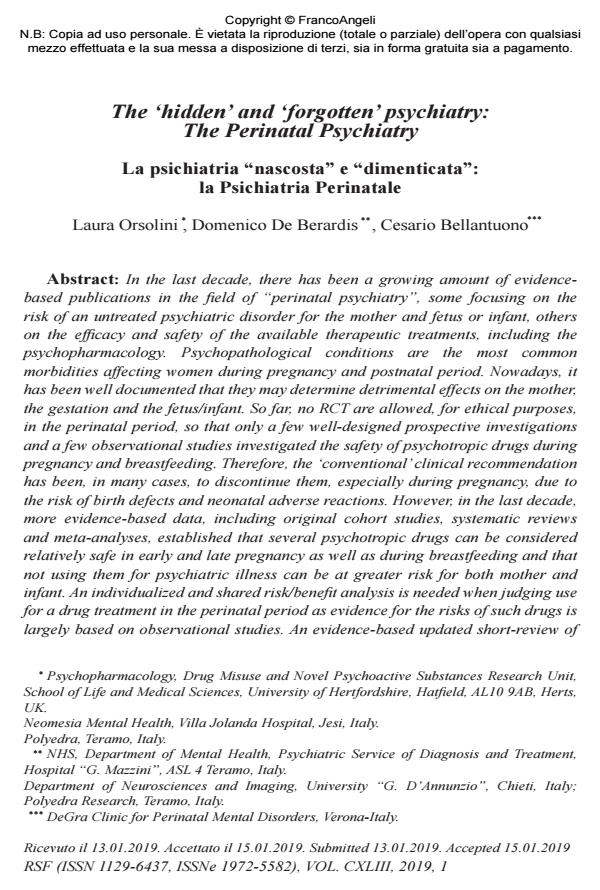The ‘hidden’ and ‘forgotten’ psychiatry: The Perinatal Psychiatry
Titolo Rivista RIVISTA SPERIMENTALE DI FRENIATRIA
Autori/Curatori Laura Orsolini, Domenico De Berardis, Cesario Bellantuono
Anno di pubblicazione 2019 Fascicolo 2019/1
Lingua Inglese Numero pagine 24 P. 35-58 Dimensione file 1895 KB
DOI 10.3280/RSF2019-001003
Il DOI è il codice a barre della proprietà intellettuale: per saperne di più
clicca qui
Qui sotto puoi vedere in anteprima la prima pagina di questo articolo.
Se questo articolo ti interessa, lo puoi acquistare (e scaricare in formato pdf) seguendo le facili indicazioni per acquistare il download credit. Acquista Download Credits per scaricare questo Articolo in formato PDF

FrancoAngeli è membro della Publishers International Linking Association, Inc (PILA)associazione indipendente e non profit per facilitare (attraverso i servizi tecnologici implementati da CrossRef.org) l’accesso degli studiosi ai contenuti digitali nelle pubblicazioni professionali e scientifiche
In the last decade, there has been a growing amount of evidencebased publications in the field of "perinatal psychiatry", some focusing on the risk of an untreated psychiatric disorder for the mother and fetus or infant, others on the efficacy and safety of the available therapeutic treatments, including the psychopharmacology. Psychopathological conditions are the most common morbidities affecting women during pregnancy and postnatal period. Nowadays, it has been well documented that they may determine detrimental effects on the mother, the gestation and the fetus/infant. So far, no RCT are allowed, for ethical purposes, in the perinatal period, so that only a few well-designed prospective investigations and a few observational studies investigated the safety of psychotropic drugs during pregnancy and breastfeeding. Therefore, the ‘conventional’ clinical recommendation has been, in many cases, to discontinue them, especially during pregnancy, due to the risk of birth defects and neonatal adverse reactions. However, in the last decade, more evidence-based data, including original cohort studies, systematic reviews and meta-analyses, established that several psychotropic drugs can be considered relatively safe in early and late pregnancy as well as during breastfeeding and that not using them for psychiatric illness can be at greater risk for both mother and infant. An individualized and shared risk/benefit analysis is needed when judging use for a drug treatment in the perinatal period as evidence for the risks of such drugs is largely based on observational studies. An evidence-based updated short-review of general principles and recommendations to help clinicians in the use of psychotropic medications during the perinatal period are provided, according to the best recent international guidelines, overviews of the literature and expert opinions in the field of perinatal psychiatry and psychopharmacology.
Negli ultimi decenni, si è assistito ad un crescente interesse nello studio e pubblicazione di articoli scientifici nel campo della ‘psichiatria perinatale’, molti dei quali specificatamente indirizzati alla valutazione ed identificazione degli eventuali rischi per la madre ed il feto/nascituro, connessi ad una patologia psichiatrica non trattata; altri specificatamente rivolti allo studio dell’efficacia e sicurezza dei trattamenti (ivi compresi quelli psicofarmacologici) finora riconosciuti e disponibili per la gestione della patologia psichiatrica durante il periodo perinatale. In generale, le condizioni psicopatologiche sono le principali condizioni riscontrabili in comorbidità nelle donne in gravidanza e/o puerpere. Oggigiorno, è stato ben documentato come tali condizioni morbose di tipo psichiatrico possano determinare gravi e rilevanti effetti sulla salute della donna, del feto e del futuro nascituro. Le problematiche di ordine etico, ovviamente limitano l’avvio di studi sperimentali specificatamente rivolti alle donne in gravidanza e/o durante l’allattamento, e molti dei dati finora disponibili provengono da studi osservazionali e prospettici che specificatamente indagano la sicurezza degli psicofarmaci durante il periodo perinatale. Sebbene l’iniziale raccomandazione generale da parte dei professionisti della salute mentale (e non solo) fosse quella di interrompere (arbitrariamente) ogni psicofarmaco assunto dalla madre durante la gravidanza e/o allattamento e di non intraprendere alcun trattamento psicofarmacologica durante il periodo perinatale (anche se necessario clinicamente), i dati recentemente pubblicati hanno permesso negli ultimi anni di investigare in modo più puntuale (e scientificamente razionale) tutte le strategie terapeutiche durante il periodo perinatale. In generale, si consiglia una analisi individualizzata, sempre condivisa con la coppia genitoriale, del bilancio rischi/benefici del trattamento come anche del non trattamento di una patologia psichiatrica durante il periodo perinatale. Il presente manoscritto presenterà una breve revisione aggiornata delle principali raccomandazioni e principi generali di pratica clinica nell’ambito della patologia psichiatrica perinatale, al fine di consentire una scelta e razionalizzazione, nonché individualizzazione, del trattamento psicofarmacologico di tali condizioni in epoca perinatale.
Parole chiave:Periodo perinatale; psicofarmacologia; psichiatria perinatale; gravidanza; allattamento; raccomandazioni cliniche.
- Transfer of the Serotonin Modulator Vortioxetine into Human Milk: A Case Series Kendall Marshall, Palika Datta, Kathleen Rewers-Felkins, Kaytlin Krutsch, Teresa Baker, Thomas W. Hale, in Breastfeeding Medicine /2021 pp.843
DOI: 10.1089/bfm.2021.0074
Laura Orsolini, Domenico De Berardis, Cesario Bellantuono, The ‘hidden’ and ‘forgotten’ psychiatry: The Perinatal Psychiatry in "RIVISTA SPERIMENTALE DI FRENIATRIA" 1/2019, pp 35-58, DOI: 10.3280/RSF2019-001003